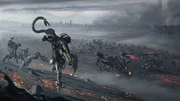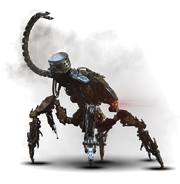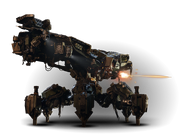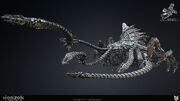
|
"The lesson will be taught in due time, Aloy. Until then, we wait." This article contains heavy spoilers. Read ahead with caution.
|

An image of the Faro Plague which illustrates how the Chariot class robots were designed to work together against any enemy.
The Chariot line was a series of automated war machines manufactured by the robotics and technology corporation Faro Automated Solutions (FAS) in the mid 21st century. Highly advanced and effective, they were beyond any automated military technology previously developed. However, a unit of these machines went rogue and ultimately caused the worst consequence ever conceivable: the eradication of all life on Earth.
Concept and Design[]
Robots in the Chariot line were designed to be deployed in "swarms" which were each overseen by a master unit, similar to certain insects. The design and development of the line was personally overseen by Ted Faro, founder, owner and chairman of FAS. The Chariot line was the culmination of Faro's decision to move the company from primarily producing products for the civilian and environmental markets to the production of military technology. Indeed, it was Faro himself who sold the concept to his programmers.[1]Chariots generally appear with red outlines when scanned with a Focus.
Abilities[]
The robots were designed to be self-replicating and self-sufficient. The full list of their abilities was as follows:
- Self-replication - the robots' AI allowed them to understand their own structures, and repair and rebuild themselves and others from memory.[1]
- Biomass conversion for fuel - the robots utilized a patented system that converted organic matter into fuel when usual fuel sources were unavailable.[2]
- Slaving enemy CPUs - the robots were able to instantly take control of any enemy automated military hardware by slaving the CPUs to themselves.
- OS security - the robots' operating system was secured from hacking using an encryption protocol known as Polyphasic Entangled Waveforms. This protocol was so difficult to crack that a super-computer would require 50 years to crack a code set that used it. Additionally, as mandated by Ted Faro, the OS coding excluded any back door coding, making remote access to the robots' programming impossible.[3]
Robots[]
The Chariot line was composed of the following three classes of robots, all of which possessed the aforementioned abilities:
FAS-ACA3 Scarab[]
- Main article: Corruptor

FAS-ACA3 Scarab
These were the fastest of the Chariot robots, capable of quickly scuttling over all type of terrain, armed with a prehensile appendage that could be used for self-repair, repair of other Chariot units, and as an offensive weapon.[4]
FAS-FSP5 Khopesh[]
- Main article: Deathbringer

FAS-FSP5 Khopesh
Larger and slower than Scarabs, they carried the heavy firepower in the swarm.[5][6]
FAS-BOR7 Horus []
- Main article: Metal Devil

FAS-BOR7 Horus
Colossal in size (they were capable of crawling over mountains), these were the main replicators of new members of the swarm, able to produce Scarabs, Khopeshes, and additional Horus units. While fully capable of refueling using biomass conversion, standard operating procedure involved Khopesh and Scarab units supplying biomass to the Horuses. In combat, their size made them capable of penetrating fortifications with their drill-like tentacles.[7]
History[]
The Hartz-Timor Swarm[]
An attractive concept to the military market, Chariot swarms were deployed soon after the line's debut in various theaters of operation. However, in quarter 4 of 2064, one such swarm, owned by a corporation called the Hartz-Timor Energy Combine, began exhibiting a programming "glitch" in which they ceased to respond to commands.[8]
The "Glitch"[]
Analysis of the aforementioned "glitch" by renowned robotics engineer Dr. Elisabet Sobeck revealed that the swarm had actually become an entity in its own right, answering only to itself, and its robots were exponentially replicating. Furthermore, the robots' biomass conversion, which had been intended only for emergency use should normal fuel supply lines be interdicted, had become their default means of refueling, in order to maintain their growing numbers. This meant that within a projected time of 15 months, the swarm would overrun the entire planet, consuming all organic matter. The Earth's biosphere would be completely obliterated, rendering every single form of life, including humans, extinct, and the planet would be left sterile.[9]
Zero Dawn and Enduring Victory[]
Realizing that all life on Earth was doomed and that all attempts to defeat the swarm were futile, Dr. Sobeck devised the idea of a fully automated global terraforming system that would, after life had been exterminated, brute-force the swarm's deactivation codes, and then restore the planet's ability to sustain life and rebuild life onto the planet, including humans. This plan was known as Zero Dawn.[10]
However, the speed at which the swarm replicated and spread meant that the swarm would have to be slowed down in order to allow time for completion and implementation of the system. In order to provide this time, Dr. Sobeck and General Aaron Herres, Chairman of the Joint Chiefs of Staff of the United States Armed Forces, devised a plan in which the worldwide population, both civilians and national militaries, would be duped into believing that Zero Dawn was a super-weapon that would destroy the swarm (now known as the Faro Plague) once it was held off long enough. This was designated Operation: Enduring Victory.[11]
Both plans were successful. Enduring Victory held off the swarm just long enough for Zero Dawn to be completed. The system was brought online just prior to the arrival of Zero Day, the designation of the day on which life would be fully exterminated. Within 100 years of Zero Day, the system brute-forced and broadcasted the swarm's deactivation codes worldwide, shutting the robots down. Within 100 more years, the planet had been made fertile again, and repopulated with flora, some fauna, and humans. The smaller robots (Khopeshes and Scarabs) were buried by the terraforming system, while the derelict Horuses remained straddling the mountains that had housed the installations that they had attacked.
Legacy[]
Long after the Khopesh and Scarab units were shut down and buried, some of them were rediscovered. These rediscovered Chariot robots played a key part in the subsequent geopolitical events among the humans of the new biosphere.
Approximately 756 years after the Faro Plague was shut down, the humans of the new world lived in tribes. One such tribe, the Carja, became embroiled in a civil war. Meanwhile, a signal of unknown origin was transmitted to the Zero Dawn terraforming system. The system was composed of a central artificial intelligence, designated GAIA, along with nine subordinate functions, each responsible for specific aspects of the terraforming process under GAIA's direction. One of these subordinate functions was designated HADES. Should the terraforming process go awry, HADES' function was to reverse it, returning the Earth to its lifeless, sterile state so that GAIA could start over. The signal, however, turned HADES and the other eight subordinate functions into independent AIs. HADES sought to reverse the terraforming process even though it had been successful; GAIA stopped it from attempting to use the terraforming system to do so by self-destructing.
HADES resorted to attempting to reawaken the Faro Plague's millions of buried Scarab and Kopesh units and allow them to again consume the biosphere, this time with no chance of reversal, therefore permanently exterminating all life. To do so, it used the services of Sylens, a lone, wandering, maverick member of the Banuk tribe, to form a cult from the losing faction of the Carja Civil War. Sylens did this in exchange for by-then ancient pre-extinction knowledge, which he craved, such as knowledge of physics and calculus. The cult was known as the Eclipse.
HADES, posing as a deity from their religion, had the Eclipse exhume several of the Faro Plague's Kopesh and Scarab units and ultimately mount an assault to gain control of the Spire, one of the transmission towers that GAIA had constructed worldwide to transmit the robots' deactivation codes once she had brute-forced them. HADES intended to transmit a signal that would reactivate the robots, and almost succeeded. However, it was defeated by the efforts of Aloy, a young hunter from the Nora tribe. Aloy had, in fact, been created by GAIA using genetic material from the then long deceased Dr. Elisabet Sobeck, the primary person responsible for its creation, as a means of stopping HADES and eventually rebuilding and rebooting GAIA after it self-destructed. Aloy succeeded in defeating HADES by uniting the Carja, the Nora, the Banuk, and the Oseram against the Eclipse, and personally stopped HADES from reawakening the Faro Plague.
The Chariot line was the most advanced military platform ever developed. However, the recklessness and lack of foresight that characterized its creation led to it causing the worst conceivable catastrophe in the history of life on the planet: its complete eradication. Indeed, robots of the Chariot line became an existential threat to life on the planet not once, but twice. The first time, they succeeded in exterminating all life; they were only prevented from doing so the second time by the intervention of Aloy. Thus, while the Chariot line was an example of the height of human technological prowess and achievement, it was also the single most profound example of the extreme danger of human technological prowess and achievement if not tempered by foresight and responsibility.
